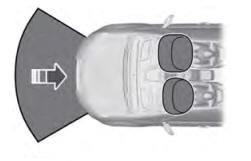Ford Explorer: High Voltage Battery, Mounting and Cables / Description and Operation - High Voltage Battery, Mounting and Cables - Overview
OVERVIEW
.jpg) WARNING:
To prevent the risk of high-voltage shock, always follow
precisely all warnings and service instructions, including instructions
to depower the system. The high-voltage system utilizes approximately
300 volts DC, provided through high-voltage cables to its components and
modules. The high-voltage cables and wiring are identified by orange
harness tape or orange wire covering. All high-voltage components are
marked with high-voltage warning labels with a high-voltage symbol.
Failure to follow these instructions may result in serious personal
injury or death.
WARNING:
To prevent the risk of high-voltage shock, always follow
precisely all warnings and service instructions, including instructions
to depower the system. The high-voltage system utilizes approximately
300 volts DC, provided through high-voltage cables to its components and
modules. The high-voltage cables and wiring are identified by orange
harness tape or orange wire covering. All high-voltage components are
marked with high-voltage warning labels with a high-voltage symbol.
Failure to follow these instructions may result in serious personal
injury or death.
NOTICE: The high voltage battery in a Hybrid Electric Vehicle (HEV) can be affected and damaged by excessively high temperatures. The temperature in some body shop paint booths can exceed 60°C (140°F). Therefore, during refinishing operations, the paint booth temperature must be set at or below 60°C (140°F) with a bake time of 45 minutes or less. Temperatures exceeding 60°C (140°F) or bake durations longer than 45 minutes require the high voltage battery be removed from the vehicle prior to placing in the paint booth.
The vehicle is powered primarily by an internal combustion engine, much like any ordinary vehicle. However, it also transforms the energy that is normally wasted during stop and go operation (when coasting and braking) into electricity. The generated electricity is stored in the high voltage battery until it is needed by the electric motor or the 12-volt system. The electric motor supports the engine during acceleration and uphill driving.
In low-speed driving situations the vehicle may move under only battery power and without the internal combustion engine running. The internal combustion engine may automatically shut off when the vehicle is stopped/idling or when coasting under 100 km/h (62 mph). The engine may restart when the accelerator is pressed, when the electric motor needs assistance, or if the high voltage battery state of charge is low. This avoids using excess fuel when the vehicle is not in motion.
The energy provided by the engine and the regenerative braking, via the electric motor (used as a generator) charges the high voltage battery.
The high voltage battery pack consists of the following servicable components:
- BECM
- High voltage battery mounting brackets
- High voltage battery upper cover seal
- High voltage battery lower seal
- Coolant port assembly
- Vent patch
- High voltage battery electronics wiring harness (includes the high voltage cell array negative cable)
- High voltage battery junction box
- High voltage high current fuse (mounted in the high voltage battery junction box)
- High voltage low current fuse (mounted in the high voltage battery junction box)
All of the high voltage battery components listed above can be serviced separately. All other components are serviced as part of the high voltage battery pack and should not be removed. If the high voltage battery pack is replaced it includes all of the components in the list.
The high-voltage system consists of the following components:
- High-voltage battery cable
- Electric motor 3 phase AC cable
- Inverter System Controller (ISC) also known as the SOBDMC
- Electric motor assembly (mounted to the front of the transmission)
- Direct Current/Direct Current (DC/DC) converter control module
- ACCM and A/C compressor assembly located on the lower LH side of the engine block
- High voltage battery pack
 Description and Operation - High Voltage Battery, Mounting and Cables - System Operation and Component Description
Description and Operation - High Voltage Battery, Mounting and Cables - System Operation and Component Description
System Diagram
Item
Description
1
Current Sensor
2
Contactor Sense Leads
3
BECM
4
Precharge Contactor Coil
5
Positive Contactor Coil
6
Negative ..
Other information:
Ford Explorer 2020-2025 Service Manual: Removal and Installation - Audio Controls
Special Tool(s) / General Equipment Interior Trim Remover Removal NOTE: Removal steps in this procedure may contain installation details. All vehicles Remove the upper instrument trim panel. Remove the screws. Torque: 22 lb...
Ford Explorer 2020-2025 Service Manual: Description and Operation - Planetary Assembly
Planetary Gearset Exploded View Item Description 1 Ring gear No. 1 2 Sun gear No. 1 3 Planetary carrier No. 1 4 Sun gear No. 2 5 Planetary carrier No...
Categories
- Manuals Home
- 6th Generation Explorer Owners Manual
- 6th Generation Explorer Service Manual
- General Procedures - Rear Camber Adjustment
- Engine - 2.3L EcoBoost (201kW/273PS)
- Description and Operation - Identification Codes
- New on site
- Most important about car
Driver and Passenger Airbags
WARNING: Do not place your arms on the airbag cover or through the steering wheel. Failure to follow this instruction could result in personal injury.
WARNING: Keep the areas in front of the airbags free from obstruction. Do not affix anything to or over the airbag covers. Objects could become projectiles during airbag deployment or in a sudden stop. Failure to follow this instruction could result in personal injury or death.
WARNING: Airbags can kill or injure a child in a child restraint. Never place a rear-facing child restraint in front of an active airbag. If you must use a forward-facing child restraint in the front seat, move the seat upon which the child restraint is installed all the way back.


